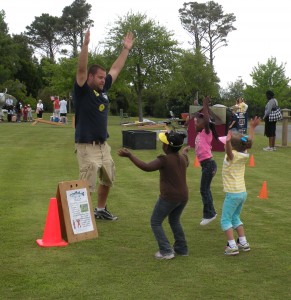Wildlife Olympics

Originally appears in the Summer 2013 issue
CAN YOUR STUDENTS do the sideways crabwalk to escape a predator, jump over obstacles like a deer, waddle to the water like a duck, slither through the woods like a snake, or hang out with a bat? Although humans lack the physical characteristics to effortlessly accomplish some of these feats, trying to imitate the movements and habits of native wildlife in your part of the world will make young people realize the special adaptations and uniqueness to be found in local ecosystems. The Wildlife Olympics are a series of activities that can be used in your elementary class as a cross-curricular activity incorporating elements of science and physical education, or as a school-wide event to raise awareness about local wildlife.
Wildlife Olympics “events” mimic the movements of native animals as they engage in everyday activities such as searching for food; escaping from predators; communicating with each other; resting during the day; locating secure places to sleep; and prowling, hopping, spinning, swimming, or flying their way through life.
In addition to providing an opportunity for inquiry learning and a greater understanding of the natural world, the Wildlife Olympics lesson is a great way to get your elementary students outdoors and participating in active play and learning.
Most Wildlife Olympics events can also be held indoors, but that will limit some of the authenticity and health benefits of the activities. You might also decide to set up a Wildlife Olympics Course along a nature trail at your school or a park, similar to the one at St. Catherine Creek National Wildlife Refuge that inspired this lesson. (See www.fws.gov/saintcatherinecreek/education.html.)
Through the process of inquiry, students can construct a greater understanding of the natural and human-designed worlds. The Wildlife Olympics are a way to help your students discover new knowledge about the native animals in your local area, such as: How are local ecosystems organized? How do they change with the seasons? How do they interrelate? And what is the role of the various species of animals that inhabit our local ecosystem? The lesson can easily be adapted to include animals that your students are likely to encounter in their own region.
Getting Started
Age/Grade Level: This Wildlife Olympics lesson is intended for elementary students, especially those in grades K-2. However, it would also appeal to older elementary students at a spring field day or ‘Wildfest’ event, especially if competition were included, such as a ‘Crabwalk Olympic Race’ with qualifying heats for each grade level. Your school might also want to use the concept of “cascading leadership” by teaching the lesson to high school students, who then conduct the Wildlife Olympics for elementary students.
Equipment: Information cards are included in this lesson (see below, at www.greenteacher.com/contents100), but you can adapt the number and types of species to suit your local situation. It is recommended that you make and laminate an enlarged Fact Sheet including the animal’s photo, characteristics, and movement instructions for each animal at your Wildlife Olympics stations. Post the Fact Sheets on a signpost like those used by realtors, or a “sandwich board” to sit on the ground. Students then rotate among the different “Olympic” events. Students can participate individually or in groups.
Use cones to mark the end point of the races, or have students race to the cone and back if space is limited. Some events require a stopwatch for timing the event. Jumping events might require a log, or high jump equipment, as well as a method to measure the height the students jump.
Some events may require special equipment. A 2×4 laid on the ground can be used for a course to “balance like a squirrel.” A ball is needed for the “eagle eye” event, and a plastic spider attached to the end of a string for the “ballooning” of the spider. Use monkey bars on the playground as a bat hanging station. Use your imagination, depending on the animals you choose to include in your own Wildlife Olympics.
Conducting your own Wildlife Olympics event will help your students develop inquiry skills as they learn about and research the native animals they are trying to mimic. This lesson is also a great example of place-based education; as Stephen Skoutajan stated in the Fall 2012 issue of Green Teacher, “According to the best studies on environmental inquiry and place-based education it is significant gains in student achievement that proves its immeasurable impact.” Let the Olympics… and the achievement gains… begin!
To view the lesson and the photo-rich magazine version, click here.
If you are not already a subscriber, please subscribe to read the full article
Lois Nixon is a retired Environmental Educator, and was Chair of the 2011 NAAEE Conference in Raleigh, NC, where this lesson was presented by Cindy Heffley. Cindy is an educator with the U.S. Fish & Wildlife Service at the Alligator River/Pea Island National Wildlife Refuges in Manteo, North Carolina. This lesson was adapted from the Animal Olympics course created along the nature trail at St. Catherine Creek National Wildlife Refuge, near Natchez, Mississippi. The images in the following cards were created by the US Fish & Wildlife Service.
Leave a Reply
You must be logged in to post a comment.










